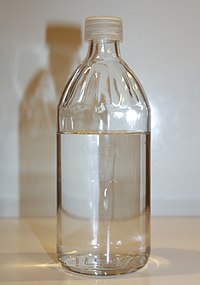
Photo from wikipedia
Abstract This work focused on developing a simple experimental method to evaluate the feasibility of using a wiped-film evaporation technique for the purification of thermally labile components. In particular, the… Click to show full abstract
Abstract This work focused on developing a simple experimental method to evaluate the feasibility of using a wiped-film evaporation technique for the purification of thermally labile components. In particular, the method was evaluated in the purification of reactor effluents from a tributyl citrate (TBC) production process, which contained 22 wt% butan-1-ol (BuOH), and 78 wt% TBC. Initially, thermal properties of TBC useful to define constrains in the evaporation process were obtained by differential scanning calorimetry and thermogravimetric analysis at 74.6 kPa. Calorimetric results indicate that TBC boils around 571.4 K with simultaneous decomposition starting at 440 K but with on-set decomposition temperature of 609.6 K. The average liquid heat capacity of TBC in the evaluated range (286.5–442.5 K) was 2.15 kJ/kg K. Once the limiting temperatures for the evaporation process were identified, steady-film tray evaporation of TBC-BuOH mixtures was carried out under vacuum at different temperatures (373–408 K), film thickness (1 and 2 mm) and processing times (0.5–5 min). Subsequently, continuous lab and pilot scale wiped film evaporators were used to concentrate the liquid mixtures under vacuum at different temperatures (373–403 K) and residence times (0.2–2 min). Comparison among the different scales and evaporation methods was done with respect the volatiles content removal and APHA color of the product. For comparison, the overall heat transfer coefficient (U) were calculated at the different scales. Modeling of the evaporation process was carried out taking into account the non-ideal vapor–liquid equilibria with the UNIQUAC equation.
Journal Title: Chemical Engineering Research and Design
Year Published: 2019
Link to full text (if available)
Share on Social Media: Sign Up to like & get
recommendations!